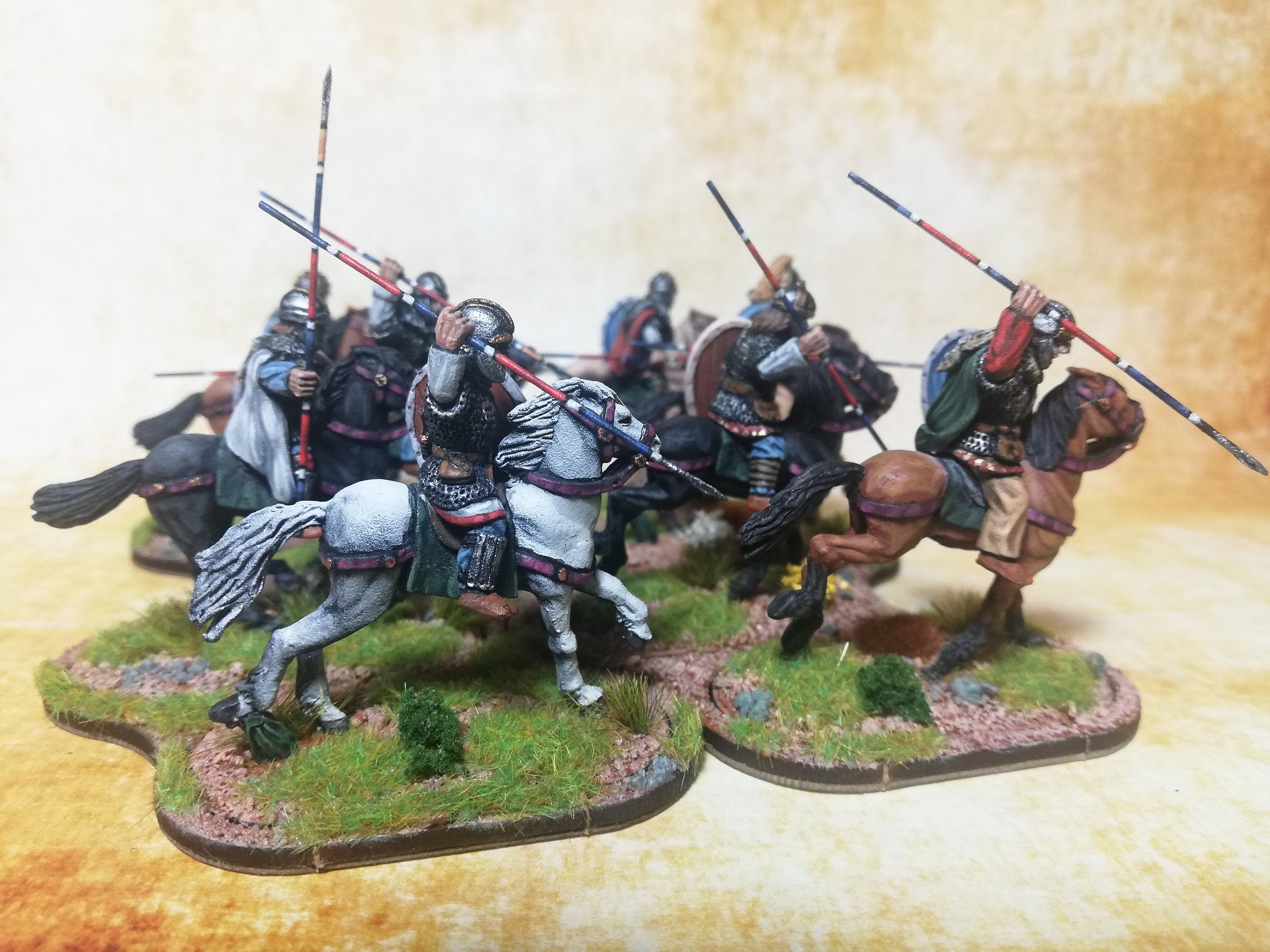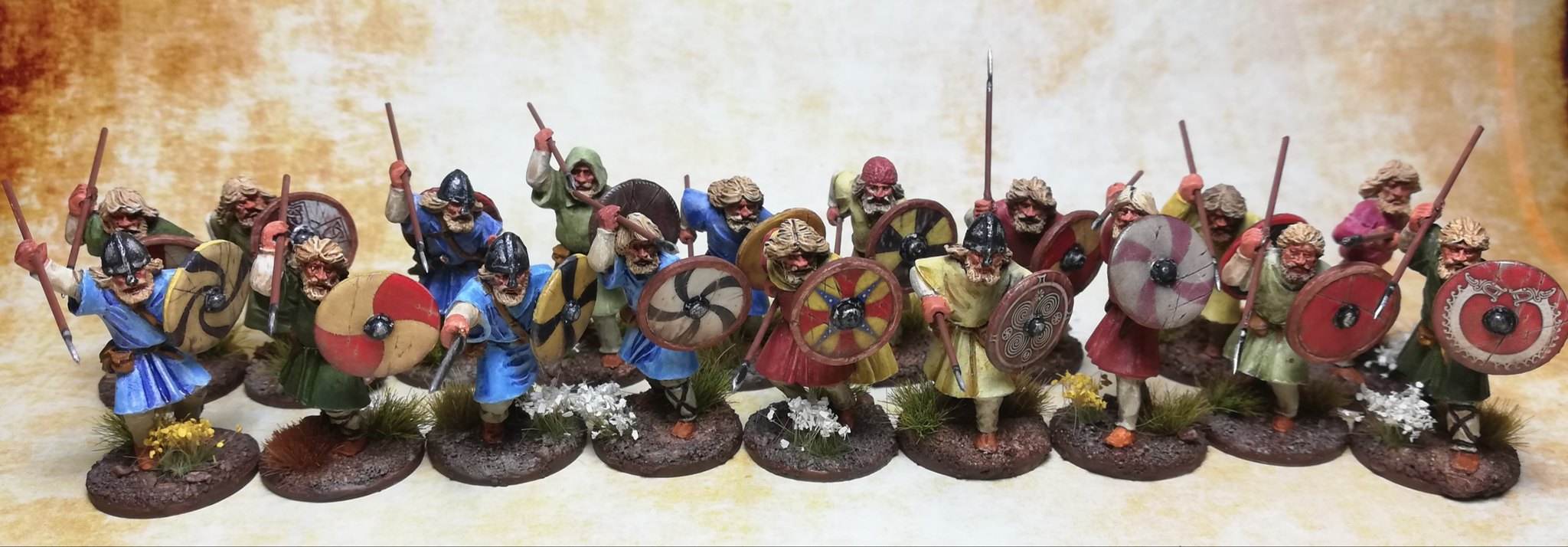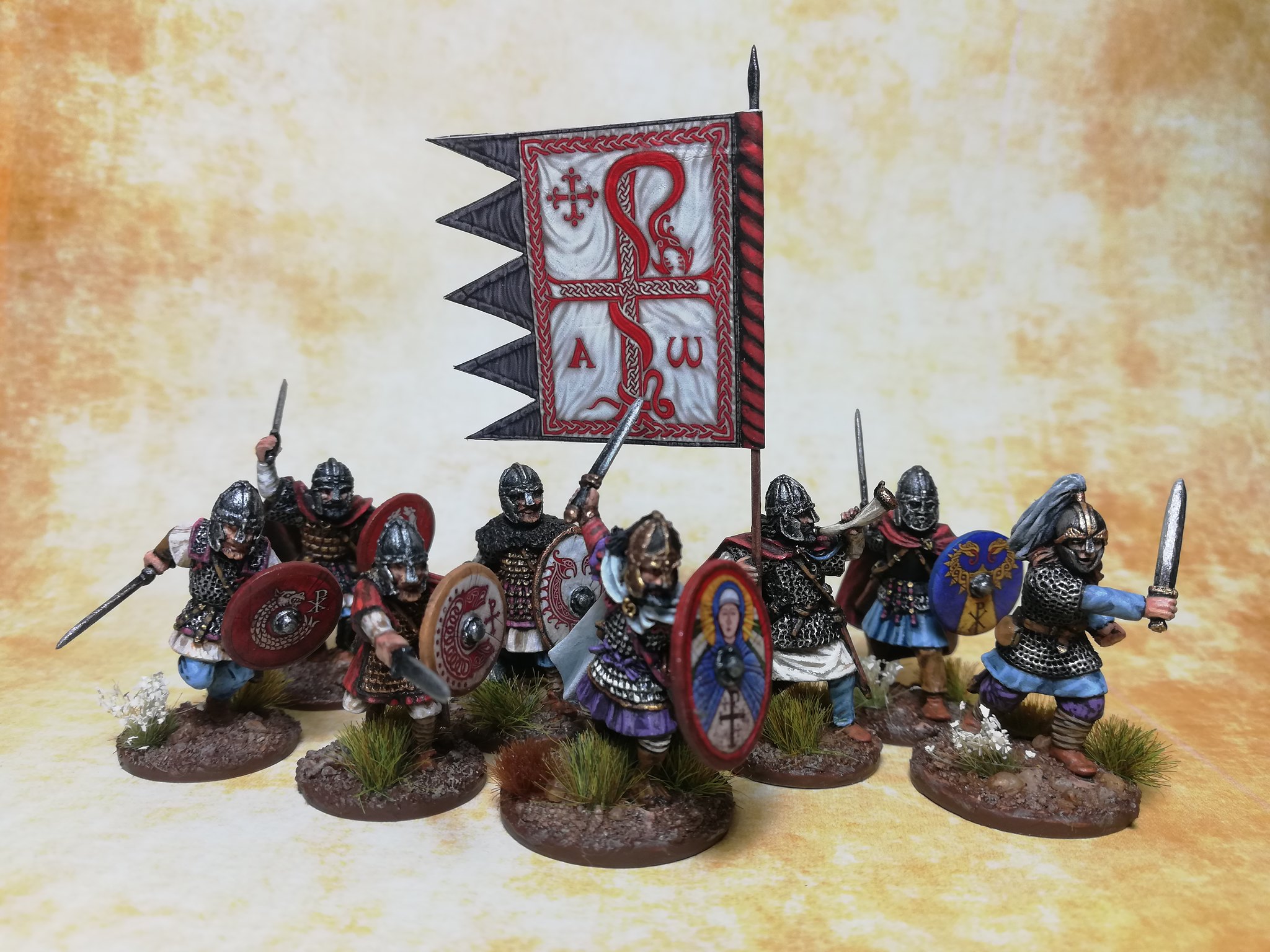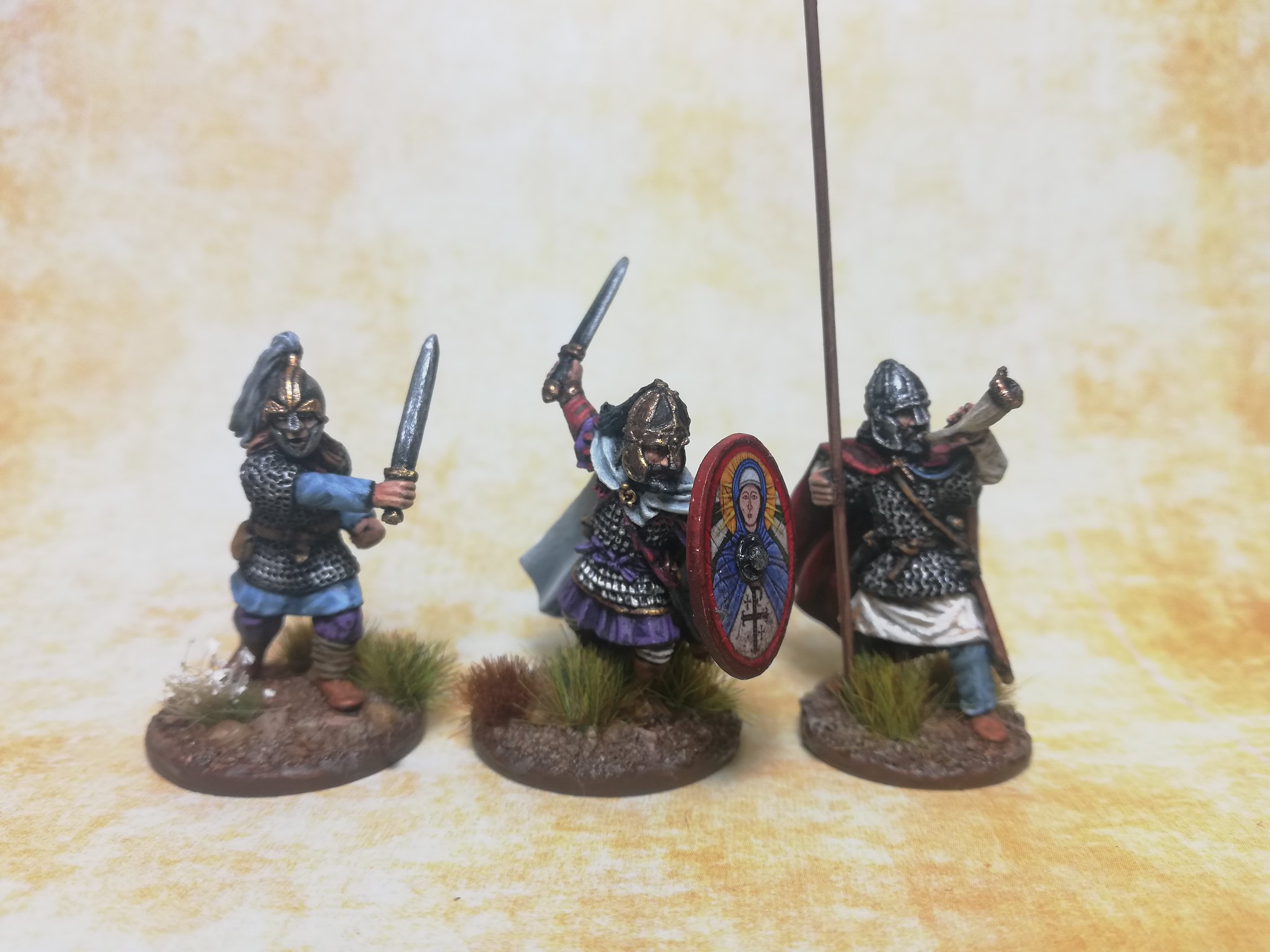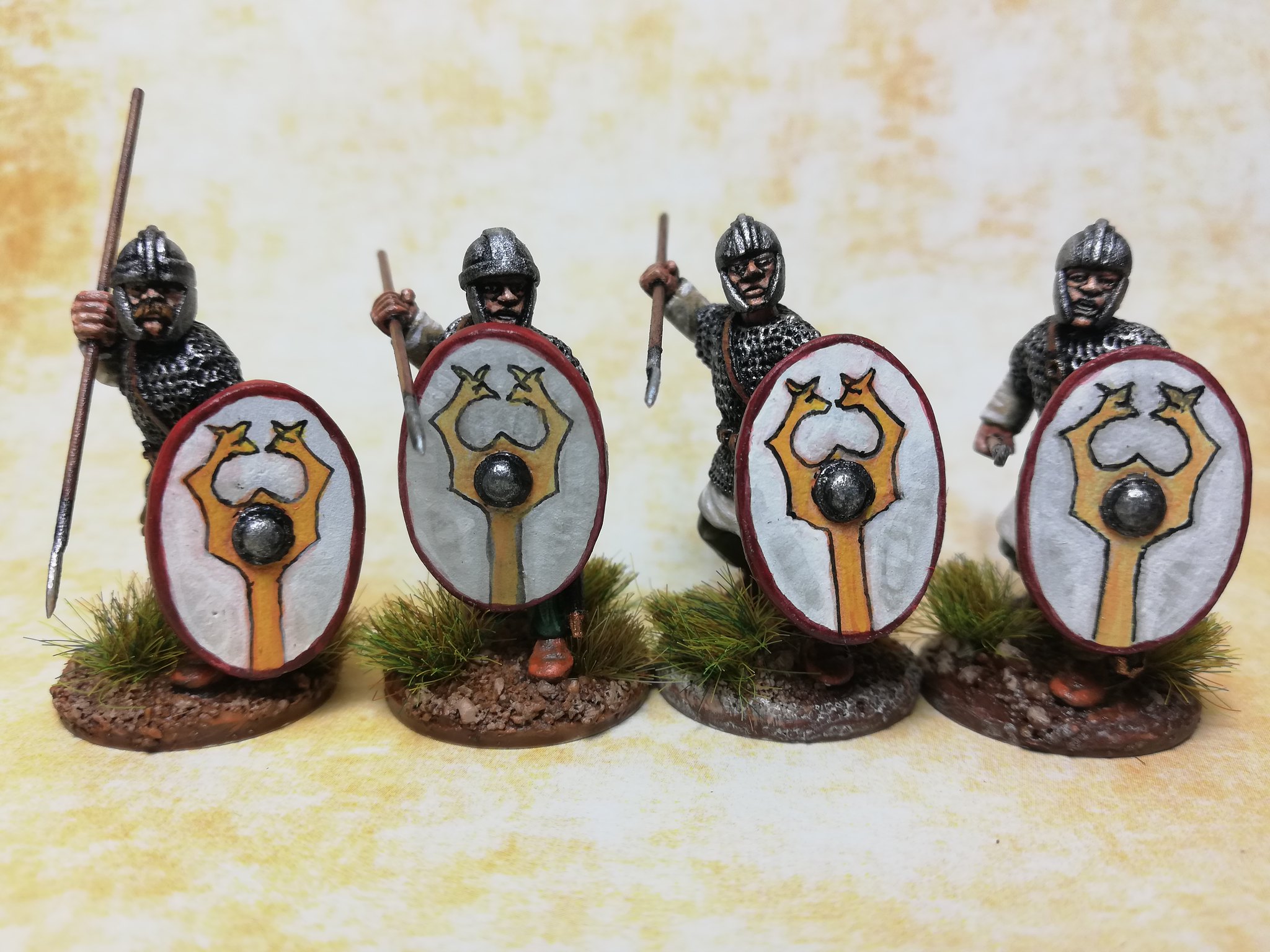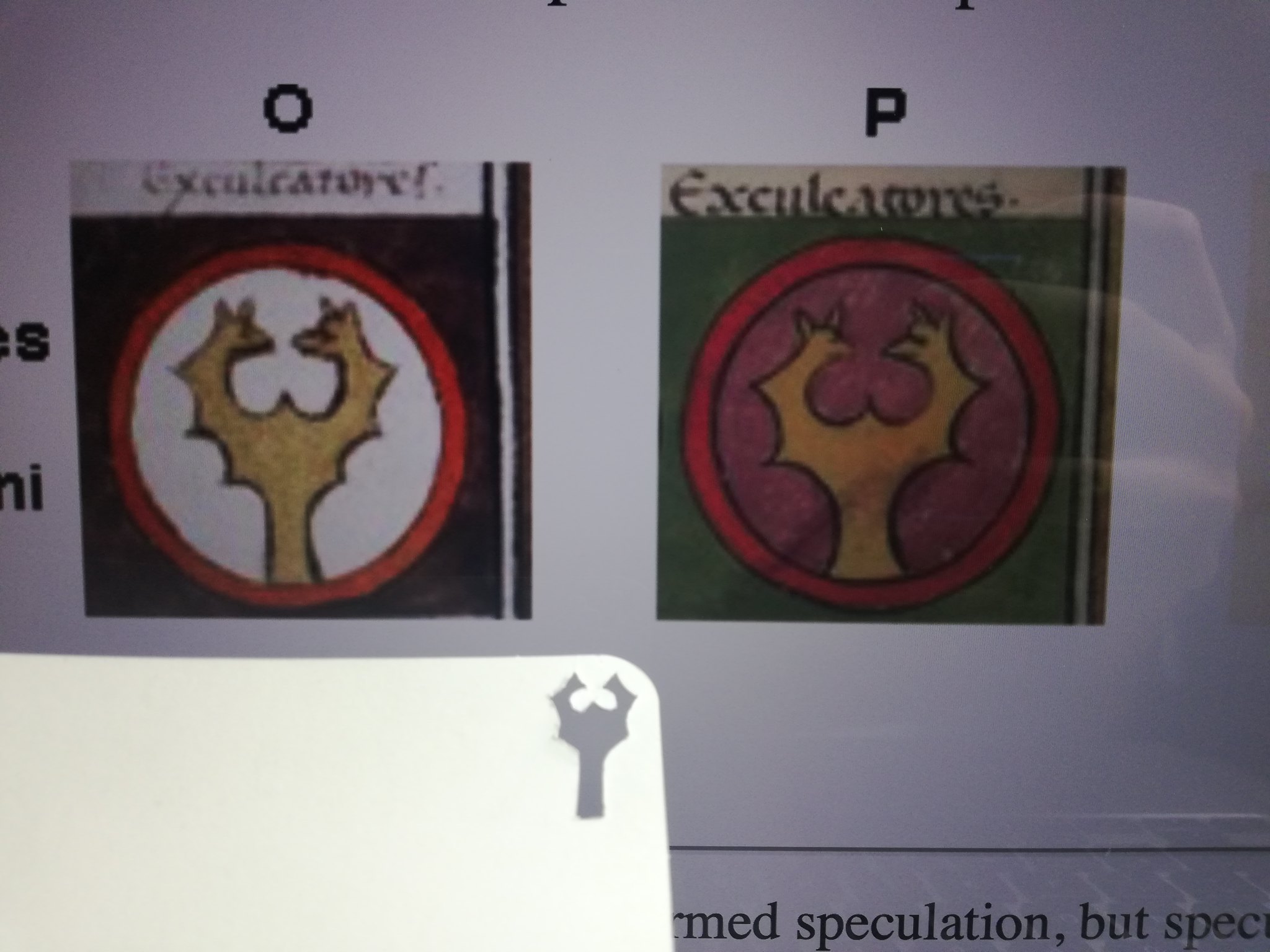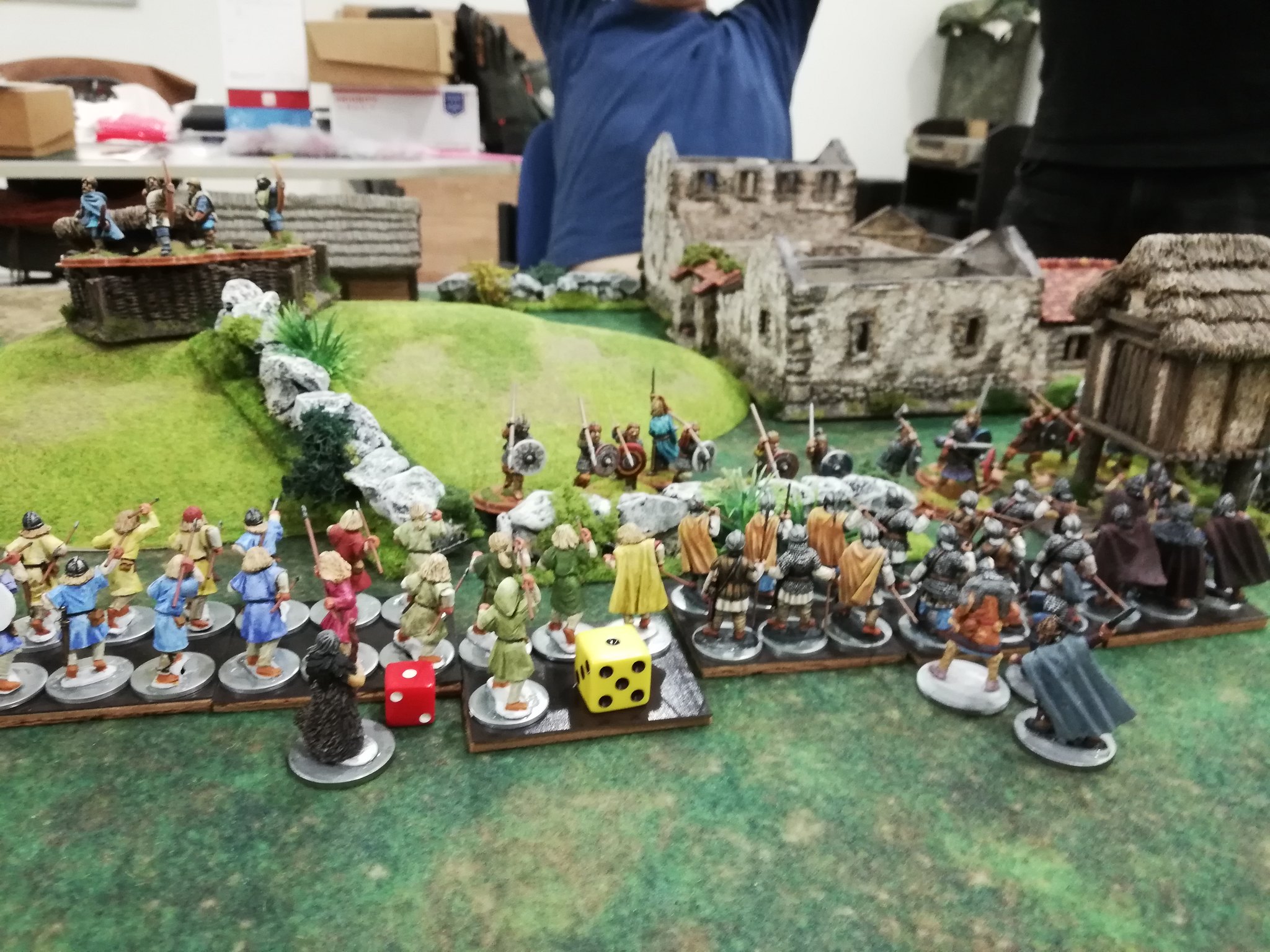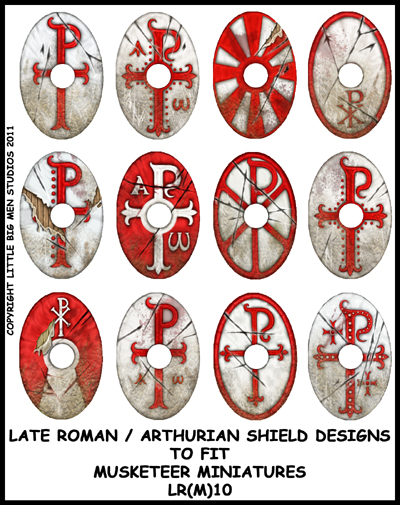It's been two months since my last completed unit, but I'm back with some major progress. Eight Romano-British cavalry from Footsore to bolster my forces.
They'll serve as Hearthguard for SAGA, Noble/Ordinary cavalry for Dux Bellorum and mounted Men of the North for Dux Britanniarum. The latter role inspired me to draw on the early medieval Welsh poem Y Gododdin by Aneirin for inspiration for the colour scheme of the riders and their horses.
These are the first cavalry I've painted since some Gary Morley Silver Helms way back in 1998 - 21 years! :D
Back to history. There is a wealth of guidance for painters in the text of Y Gododdin which I've compiled below in case anyone is interested.
Y Gododdin
Costume Notes
Numbers in parentheses refer to stanza followed by line.
Broad lightweight shield (1:5)
Gold-bordered garments (1:8 )
Betorqued (many)
Mail-coat (3:7)
Lime-white shields (11:6)
Blaen took delight in gold and purple (16:6)
Gold-fretted shield (29:3)
Swift steeds and dark-blue war-gear and shields (33:2)
One who wore purple (67:4)
Ice-bright shields (71:13)
Horses
Roan (26:8 )
A trim long-legged grey (50:4)
Darker (brown) his saddle (50:6)
Grey steeds (58:11)
Red steeds (61:7)
White horses (74:5)
Dapple-grey steed (77:5)
What I finally settled on was a mashup of qualities drawn from the poem and Late Roman equipment. The "lime-white shields" were a must.
I had to make sure they didn't look too bright, flat or bland. I used a base coat of Foundry Quagmire B (a brown grey) and several thin coats of Canvas C (an off white). I tried to approach them as if I was painting lime onto leather-faced shields.
To give them more depth I weathered them with a drybrush of Quagmire B and Rawhide A. Tried a couple of shield cuts but my brush hand wasn't steady enough to get really thin straight lines done so well.
I also incorporated some "gold-bordered garments".
To give them some elite flavour I pimped up their spears with the stripes that seem to be a Late Roman thing (anyone know the source of these?).
Part of the painting challenge here was to produce sufficient variety in the colour schemes so that multiples of the same model looked different. Among the eight figures there are only six different riders and three different horses. Luckily, the notes from the poem really gave me an excuse to crack open many of the pots in Foundry's Horse Paint set.
I'd only painted dapple greys and whites before this so it was a nice challenge to attempt blacks, chestnuts, bays and a roan. The roan is the toughest to pull off since they have equal amounts of interspersed white and coloured hairs, something which you can only impart impressionistically in paint. While blacks aren't mentioned specifically in Y Gododdin, other Welsh literature mentions Arthur riding a black mare so I wanted to get some practice in before I painted the dux bellorum.
EDIT: I found that different painting techniques worked better for different horse colours, from normal layering (for the bays and lighter browns) to drybrushing (for the blacks) to zenithal for the greys.
Next up on the workbench is Arthur himself with the costume colours drawn from a mix of Bernard Cornwell's trilogy and the Mabinogion. The latter provides some names of Arthur's arms. I'm still trying to figure out what motif to place on his shield which was called Wynebgwrthucher (face of the evening). Perhaps a Celtic moon or star.
Showing posts with label Footsore. Show all posts
Showing posts with label Footsore. Show all posts
Friday, 9 August 2019
Thursday, 16 May 2019
Sabot basing - A Method
Since I'm playing a mix of games from those requiring individually-based models to element-based games, having sabot bases is useful to make the most each painted model.
I finally got round to testing out the sabot basing method that I've carried in my mind for months. I've documented it below as an aide memoire and in case anyone else can benefit or improve on the method.
Here's the finished result:
This is a 12cm-wide sabot base intended to serve for Impetus, To the Strongest, Hail Caesar, Dux Bellorum and any other element-based game I care to play.
The Steps
1. First, stick some thin magnetic sheet down on MDF. Above is a 1mm magnetic sheet from Popular Bookstore (the stuff from Daiso is too weak) glued with PVA to 3mm MDF. I'd prefer 2mm MDF, but its not available locally and this stuff was custom cut cheap in bulk by a local framing shop.
Arrange the minis into a comfortable formation, particularly so their spears don't poke each other.
Then, mark the position of each figure with a 20mm steel washer, which acts as a placeholder. You don't want to mess up your nicely based minis with raw filler and sand!
You can see them above under the painted minis. I base all my figures on 20mm washers so the magnetic system works. The washers have the advantage of being heavy enough to keep even the most unbalanced figure upright.
2. Apply a layer of filler around the placeholder washers. Liberally sprinkle this over with fine to coarse sand while its still wet. You can always brush water on the semi-dry filler to help the sand adhere. Leave to dry and shake off the excess sand. If there are any bare areas just touch them up with PVA and sand. I use coloured filler which is close to Sienna in colour. It is less troublesome to use than white filler which really sucks up any pigment or paint added.
When that's all dry seal the whole lot with watered-down PVA glue. This gives you a good surface to paint and drybrush the sand without it all coming off.
3. Basecoat with a preferred earth colour. I used a mix of Dark Chocolate and Burnt Sienna from Americana craft paints because they're cheap.
Then drybrush with a sand colour. I used Americana Sand with a few drops of the basecoat to tie them together.
Once that's dry, remove the placeholder washers and clean up their sockets. Make sure there is a good level and even fit for the models' bases or else the magnet won't be as effective. You may have to scrape around the cavity with a blunt sculpting tool to get a good fit. Don't make it too roomy, you want to minimise the appearance of sabot holes. Just enough for a snug but easy fit.
Then you can flock and dress the base. I recommend doing this with the figures inserted so you can disguise any obvious signs that this is a sabot base. I tried to place flock in front of the gap between the sabot and the miniature's base.
As you can see above the front row is quite well disguised. The second row could use a bit more work, but this could easily pass as a nice multi-based unit for Impetus. A future challenge would be to combine some diorama action with sabot basing.
The Test

Pretty well, I'd say.
Next Steps
In pursuit of an ever-lower base profile I plan to order some 12cm wide, 2mm deep laser-cut MDF bases from Warbases. I will use thin magnetic sheet for the bottom which carries with it the dual advantage of holding both the models and the entire base to a box lined with magnetic sheeting.
My models, based on 20mm-wide washers should sit flush with the MDF. Total depth of base to the foot of the model should be 3mm versus the 5mm in the method above.
As mentioned above, aesthetically I'd like to try some diorama action, perhaps incorporate some drama with casualty figures, or even terrain like a road or other feature to make any given base look less like a movement tray and more like a thoughtful composition.
I finally got round to testing out the sabot basing method that I've carried in my mind for months. I've documented it below as an aide memoire and in case anyone else can benefit or improve on the method.
Here's the finished result:
This is a 12cm-wide sabot base intended to serve for Impetus, To the Strongest, Hail Caesar, Dux Bellorum and any other element-based game I care to play.
The Steps
1. First, stick some thin magnetic sheet down on MDF. Above is a 1mm magnetic sheet from Popular Bookstore (the stuff from Daiso is too weak) glued with PVA to 3mm MDF. I'd prefer 2mm MDF, but its not available locally and this stuff was custom cut cheap in bulk by a local framing shop.
Arrange the minis into a comfortable formation, particularly so their spears don't poke each other.
Then, mark the position of each figure with a 20mm steel washer, which acts as a placeholder. You don't want to mess up your nicely based minis with raw filler and sand!
You can see them above under the painted minis. I base all my figures on 20mm washers so the magnetic system works. The washers have the advantage of being heavy enough to keep even the most unbalanced figure upright.
2. Apply a layer of filler around the placeholder washers. Liberally sprinkle this over with fine to coarse sand while its still wet. You can always brush water on the semi-dry filler to help the sand adhere. Leave to dry and shake off the excess sand. If there are any bare areas just touch them up with PVA and sand. I use coloured filler which is close to Sienna in colour. It is less troublesome to use than white filler which really sucks up any pigment or paint added.
When that's all dry seal the whole lot with watered-down PVA glue. This gives you a good surface to paint and drybrush the sand without it all coming off.
3. Basecoat with a preferred earth colour. I used a mix of Dark Chocolate and Burnt Sienna from Americana craft paints because they're cheap.
Then drybrush with a sand colour. I used Americana Sand with a few drops of the basecoat to tie them together.
Once that's dry, remove the placeholder washers and clean up their sockets. Make sure there is a good level and even fit for the models' bases or else the magnet won't be as effective. You may have to scrape around the cavity with a blunt sculpting tool to get a good fit. Don't make it too roomy, you want to minimise the appearance of sabot holes. Just enough for a snug but easy fit.
Then you can flock and dress the base. I recommend doing this with the figures inserted so you can disguise any obvious signs that this is a sabot base. I tried to place flock in front of the gap between the sabot and the miniature's base.
As you can see above the front row is quite well disguised. The second row could use a bit more work, but this could easily pass as a nice multi-based unit for Impetus. A future challenge would be to combine some diorama action with sabot basing.
The Test
So, how well do the magnets hold?

Pretty well, I'd say.
Next Steps
In pursuit of an ever-lower base profile I plan to order some 12cm wide, 2mm deep laser-cut MDF bases from Warbases. I will use thin magnetic sheet for the bottom which carries with it the dual advantage of holding both the models and the entire base to a box lined with magnetic sheeting.
My models, based on 20mm-wide washers should sit flush with the MDF. Total depth of base to the foot of the model should be 3mm versus the 5mm in the method above.
As mentioned above, aesthetically I'd like to try some diorama action, perhaps incorporate some drama with casualty figures, or even terrain like a road or other feature to make any given base look less like a movement tray and more like a thoughtful composition.
Wednesday, 15 May 2019
The Levy Assemble & Merlin Grumbles
I am pleased to announce the completion of my 18 Levy for my Dux Britanniarum Romano-British starter force.
This was a quick and dirty paint job as they were Saxon Miniatures (now Warlord) figures I was lukewarm about. They are originally Viking Bondi but have the advantage of a fairly generic Dark Age warrior look, especially if one is representing Germanic troops or foederati.
They were primed white then washed in a bright primary colour - blue, green, madder red, lemon yellow. This produced a natural shade in the folds, an effect I accentuated whenever the component pigments of certain paints separated, as was especially the case with the Army Painter blue. I would soak up the darker pigment and wash it into the folds.
For the lighter tones I used a standard brown wash for more detail. The hair was treated the same.
More care was applied to the shields where I went for LBMS transfers and full three-stage highlights on the back boards. For ancients infantry the old wisdom really rings true: focus on the face, the weapon and the shields and you'll be fine. A bit of care was also taken with the bases. Maybe they could use another highlight, but there was a battle to fight the next day.
Their previous outing without finished shields didn't end so well. The nasty Saxon cattle rustlers stayed out of reach despite Merlin's exhortations.
Merlin himself has now been finished.
Inspired by Bernard Cornwell, I painted him as a grubby druid, with a sun-bleached bearskin cape and a dirty robe. People say he looks like Old Luke from the Last Jedi. I've left a bit of a gap on his base for a future decoration such as some toadstools or a skull when I have time to sculpt or mould them.
I umm'd and ahh'd about how to paint the bear fur cloak but in the end I just went with a base of Vallejo G Camo Black-Brown and applied the triads from Foundry's Bay Brown and Chestnut, about six layers in all, with a final extreme highlight of Vallejo Dark Sand to establish contrast and mimic some bleaching/weathering. It looks a bit harsh in the photo due to the lighting. I am still on the lookout for a good method to paint bear fur as well as timber wolf fur (for the champion Raedwald's coat).
I umm'd and ahh'd about how to paint the bear fur cloak but in the end I just went with a base of Vallejo G Camo Black-Brown and applied the triads from Foundry's Bay Brown and Chestnut, about six layers in all, with a final extreme highlight of Vallejo Dark Sand to establish contrast and mimic some bleaching/weathering. It looks a bit harsh in the photo due to the lighting. I am still on the lookout for a good method to paint bear fur as well as timber wolf fur (for the champion Raedwald's coat).
This leaves only the champion and Lancelot's shield to receive their final highlights. But I'm already hankering to start painting some cavalry as I've been reading Y Gododdin to get into the mood.
I also finished work on another four warriors for a total of 16 warriors to make my warband SAGA ready.
Once again, the shields were hand-painted. I experimented with patterning the highlights on the white area. Unlike the Saxon Miniatures figures above these Footsore troops were a delight to paint. The faces especially were packed with detail, rewarding the time taken to paint in the eyes. They even sculpt the eyebags!
Saturday, 20 April 2019
Arthur and his Knights Assemble
Arthur and his knights rally around their banner.
After months of painting my Elites and Arthur are done. I even managed to do my first tin foil banner with a transfer from LBMS. It was well worth it, especially after stabbing myself on its spear multiple times throughout this project!
The figures are all Saxon Miniatures (now Warlord-owned), apart from Footsore's Lancelot on the far right. He's awaiting inspiration for a suitable shield design. I'd like to use a large oval shield for him but it's a tight fit compared to a medium round shield.
More pictures of the team below. The Saxon Miniatures are from the Winter King range sculpted by Colin Patten, providing lots of choices for Knights of the Round Table. I like their poses and kit. My only complaint would be about the casting quality of their faces. The detail isn't as crisp as Footsore's faces. However, I'm very happy with their Arthur as Footsore lacks a suitably heroic Arthur on foot.
Being influenced by the Bernard Cornwell books I was all set to make my Arthur pagan. But a desire to wrap up this lot (batch painted in a group of 21 minis) led me to use a transfer from LBMS. I thought it'd be a nice tribute to Geoffrey of Monmouth's description of Arthur's shield bearing the Virgin Mary. He still bears the white cloak from Cornwell, though I couldn't settle on a better colour than black for his helmet plume. I'm open to suggestions (I did consider ochre).
I painted this group in common colours, mainly red, white and blue, varying the location to give them both uniformity and individuality. The white and blues would tie them together with the previously painted Warriors, whilst the red - especially the cloaks - would set them apart.
Arthur and Lancelet, being Lords, had purple mixed into their scheme and used grey-white rather than canvas white for elements of their costume.
I also finished up my archers. I may add patches later or leave them as poor, unadorned British archers.
Next steps are to finish painting my Merlin and champion, which had a different colour scheme to the rest. Though currently, I'm completing a manuballista and its crew, plus four more hand-painted shields to make this bunch SAGA-ready.
Saturday, 9 March 2019
Exculcatores Iuniores Britanniciani - COMPLETE
After a month long painting rut I am happy to report a burst of activity that culminated in the completion of two units of Warriors for my Dux Brit Late Romans, my first fully finished figures for this project. I even gave them my first freehand shields, and what an enjoyable process that was.
Here are the desperate dozen ready to face the long war of attrition with the invading Saxons.
For future reference, here are the colours I used, mostly Foundry and a few Vallejo:
THE SHIELDS
The shield designs are derived from the Notitia Dignitatum which lists the Exculcatores iuniores Britanniciani, though not specifically as a unit within the Comes Britanniae. I can't understate the value of Luke Ueda-Sarsson's site on the Notitia.
However, this particular shield design met my desire to have an historically plausible motif that featured white and red, reflecting what I understand were the common colours of that period. Epics such as Y Goddodin mention white shields. The WAB supplement Age of Arthur recommended red and white themes.
I nearly went the route of using LBMS transfers, but I wasn't keen on the red and white Chi-Ro designs on offer. After reading Bernard Cornwell's Warlord Trilogy I was keen on a less obviously Christian theme, though I won't exclude it entirely in the final force.
As it turned out I really enjoyed painting the design myself. Since the designs in the Notitia are depicted for round shields I had to adapt it somewhat for an oval shield.
The advantage of commercial shield transfers is uniformity, so I attempted to compensate by making a stencil from thin card. I should note here that there is speculation that the actual design may have been yellow and purple with a red border, but the Oxford version of the Notitia renders it as yellow and white with a red border. That suits me fine so I went with it.
I used the stencil to mark out the outline of the twin-headed zoomorphic creature with a micro-pen. I then blocked this in with Foundry Ochre Yellow for a warm yellow that would complement the cloaks on some of the figures that were also painted in the same colour.
I skipped a three-tone painting approach and just went for two tones. Since yellows are pigment weak I found it more effective to basecoat in yellow and wash selectively with the orangey shade tone to suggest texture and depth. For the white surrounding I based with Foundry Arctic Grey shade then outlined it with pure white.
The shield rears are wood and were painted up in a three tone style with Vallejo analogues to Foundry Spearshaft with a wash of Vallejo German Camo Black Brown after the basecoat. I was more sparing with the highlights towards the bottom of the shield.
The red edging was done with Vallejo Black Red followed by Foundry Bright Red shade with less of the brighter tone applied towards the bottom. The nail holes in the leather were picked out with my homemade black wash based off Les's Washes. The central grip was my usual steel mix.
Mounting the shields on double-sided tape on top of card made them very easy to handle and paint the designs. However, once the time came to paint the rears it became rather fiddly because the handling and accidental scraping led to the paint on the front coming off or adhering to the card.
So I had to work quickly and carefully and I chose to varnish them with gloss then matte as quickly as I could. I may return at a later date to add more highlights on the rim but they look pretty good as is.
In truth, I was too impatient to glue them to the figures and finish off the bases with tufts and declare these two units of six done.
I'm pretty happy with them though I feel the black edging of the central design could be softer as it seems too harsh to my eyes, but it does match the design in the Oxford Notitia.
For my future batch of Late Romans I'll probably use the red and white emblem of the Cornuti since I already have the transfers and it thematically echoes the design of the Exculcatores.
Side note: The Exculcatores were probably light infantry scouts according to this, but I'm using them on heavy infantry. The specific colour combination trumps history here.
I have to say that despite the time invested in hand painting the shields it was so much more satisfying and enjoyable than applying transfers. And fun is what this hobby is about. I wonder what my next freehand shields will be.
Here are the desperate dozen ready to face the long war of attrition with the invading Saxons.
For future reference, here are the colours I used, mostly Foundry and a few Vallejo:
British Warriors (Footsore Late Romans)
Armour & Weapons - Gunmetal Grey, Oily Steel, Silver
Hair - Black
Moustache & Beard - Deep Brown Leather
Belt and Pouches - Deep Brown Leather, Quagmire
Scabbards & Straps - Wine Stain Red, Black / Deep Brown Leather, Chestnut
Scabbard Tips & Sword Hilt/Butt + Buckles - Bronze
Shoes - Tan
Trousers - Union Trouser Blue / Moss Green / Forest Green
Puttees - Buff Leather
Flesh - Foundry Flesh Triad
Tunics - Canvas with Bright Red stripe or Border and circles
Neckerchief - Bright Red
Cloaks - Ochre
Spears - Spearshaft
Leather Armour - Deep Brown Leather
The shield designs are derived from the Notitia Dignitatum which lists the Exculcatores iuniores Britanniciani, though not specifically as a unit within the Comes Britanniae. I can't understate the value of Luke Ueda-Sarsson's site on the Notitia.
However, this particular shield design met my desire to have an historically plausible motif that featured white and red, reflecting what I understand were the common colours of that period. Epics such as Y Goddodin mention white shields. The WAB supplement Age of Arthur recommended red and white themes.
I nearly went the route of using LBMS transfers, but I wasn't keen on the red and white Chi-Ro designs on offer. After reading Bernard Cornwell's Warlord Trilogy I was keen on a less obviously Christian theme, though I won't exclude it entirely in the final force.
As it turned out I really enjoyed painting the design myself. Since the designs in the Notitia are depicted for round shields I had to adapt it somewhat for an oval shield.
The advantage of commercial shield transfers is uniformity, so I attempted to compensate by making a stencil from thin card. I should note here that there is speculation that the actual design may have been yellow and purple with a red border, but the Oxford version of the Notitia renders it as yellow and white with a red border. That suits me fine so I went with it.
I used the stencil to mark out the outline of the twin-headed zoomorphic creature with a micro-pen. I then blocked this in with Foundry Ochre Yellow for a warm yellow that would complement the cloaks on some of the figures that were also painted in the same colour.
I skipped a three-tone painting approach and just went for two tones. Since yellows are pigment weak I found it more effective to basecoat in yellow and wash selectively with the orangey shade tone to suggest texture and depth. For the white surrounding I based with Foundry Arctic Grey shade then outlined it with pure white.
The result was okay, but I decided to add more interest by painting white radiating marks around the yellow design to make it pop out more.
The shield rears are wood and were painted up in a three tone style with Vallejo analogues to Foundry Spearshaft with a wash of Vallejo German Camo Black Brown after the basecoat. I was more sparing with the highlights towards the bottom of the shield.
The red edging was done with Vallejo Black Red followed by Foundry Bright Red shade with less of the brighter tone applied towards the bottom. The nail holes in the leather were picked out with my homemade black wash based off Les's Washes. The central grip was my usual steel mix.
Mounting the shields on double-sided tape on top of card made them very easy to handle and paint the designs. However, once the time came to paint the rears it became rather fiddly because the handling and accidental scraping led to the paint on the front coming off or adhering to the card.
So I had to work quickly and carefully and I chose to varnish them with gloss then matte as quickly as I could. I may return at a later date to add more highlights on the rim but they look pretty good as is.
In truth, I was too impatient to glue them to the figures and finish off the bases with tufts and declare these two units of six done.
I'm pretty happy with them though I feel the black edging of the central design could be softer as it seems too harsh to my eyes, but it does match the design in the Oxford Notitia.
For my future batch of Late Romans I'll probably use the red and white emblem of the Cornuti since I already have the transfers and it thematically echoes the design of the Exculcatores.
Side note: The Exculcatores were probably light infantry scouts according to this, but I'm using them on heavy infantry. The specific colour combination trumps history here.
I have to say that despite the time invested in hand painting the shields it was so much more satisfying and enjoyable than applying transfers. And fun is what this hobby is about. I wonder what my next freehand shields will be.
Wednesday, 30 January 2019
Dux Britanniarum Learning Game
Over the weekend we had our first go at the Dux Brit rules. It shares the virtues and vices common with other Too Fat Lardies rules. The overall system is intuitive and models a good feel for the period.
However, the rules suffer from poor organisation, it's a nightmare finding things during the thick of battle. Important information is buried in wordy paragraphs when a simple list or table would suffice for easy reference and there are many situations where one just has to apply common sense to address gaps in the rules. We have similar frustrations with Chain of Command but I love the depth of that ruleset.
We played a Village Raid scenario where the Saxons have to loot said village and get away with it before the British stop them. With the Saxons have a generous four turns to saunter into the village before the game started this game was shaping up to be like cops (the British) besieging a bank heist.
I brought my Romano-Brits, which I've nearly finished painting. The prospect of this game was a good impetus to at least block in the base colours on all the figures.
I knocked up some simple magnetic movement bases since I use metal washers to base my minis. I glued magnetic sheet to 6cm wide by 5cm deep MDF. It made for a tight fit. I'm considering making bigger bases to offer more to grip on but 6cm works well for Dux Bellorum and doubling up for Impetus, so I may just keep them and dress up the exposed areas with a bit of grit and flock.
The A Strong Arm card is great! Masses and masses of shock. The Saxons broke not long after.
Them breaking Saxons by the time we called an end to the game.
However, the rules suffer from poor organisation, it's a nightmare finding things during the thick of battle. Important information is buried in wordy paragraphs when a simple list or table would suffice for easy reference and there are many situations where one just has to apply common sense to address gaps in the rules. We have similar frustrations with Chain of Command but I love the depth of that ruleset.
We played a Village Raid scenario where the Saxons have to loot said village and get away with it before the British stop them. With the Saxons have a generous four turns to saunter into the village before the game started this game was shaping up to be like cops (the British) besieging a bank heist.
I brought my Romano-Brits, which I've nearly finished painting. The prospect of this game was a good impetus to at least block in the base colours on all the figures.
I knocked up some simple magnetic movement bases since I use metal washers to base my minis. I glued magnetic sheet to 6cm wide by 5cm deep MDF. It made for a tight fit. I'm considering making bigger bases to offer more to grip on but 6cm works well for Dux Bellorum and doubling up for Impetus, so I may just keep them and dress up the exposed areas with a bit of grit and flock.
The A Strong Arm card is great! Masses and masses of shock. The Saxons broke not long after.
Them breaking Saxons by the time we called an end to the game.
Wednesday, 16 January 2019
Dux Britanniarum!
Distraction strikes once again in the land of wargaming. I have been sidetracked from my ancients project with the prospect of Dark Age gaming, specifically the Arthurian age of Late Antiquity.
Since its always more rewarding to paint for a game where there are ready players I've let myself get talked into playing Romano-Britons versus an existing army of Saxons held by gamesmaster Damon using the Two Fat Lardies' Dux Britanniarum rules.
Here are the fruits of some sporadic painting over the last few months.
First up, a near complete two groups of Roman spearmen, figures by Footsore Miniatures.
Near complete as the shields and bases aren't done yet. I'm mainly undecided on the shields. For reasons I detail below.
Part of the process of psyching myself up for this project has been consuming literature related to Arthur and the Saxon conquest/migration.
One key text has been the fantastic Age of Arthur supplement for Warhammer Ancient Battles, now out of print and rather rare or exorbitantly expensive on the second hand market. Thanks to a Facebook group I was lucky enough to contact one of the authors, James Morris, and purchased a spare copy directly from him.
(James was also kind enough to dig up a spare unpainted and out of production La Dama De Elche from Gripping Beast for my Iberian project.)
The other inspiring text has been Bernard Cromwell's smashing Arthur trilogy, the Warlord Chronicles. This series presents a largely pagan or agnostic Arthur, although in all probability whoever may have been the historical Arthur would likely have been Christian whether he was Roman or Briton.
Still, I rather fancy a pagan Arthur for my campaign, or one not so obviously Christian. This meant scrapping my original plan for a red and white shield theme based on Little Big Man Studio's Chi-Ro transfers. In any case, the design below is somewhat speculative, not being in the Notitia Dignitatum.
After a bit of research on Luke Ueda-Sarsson's excellent site on the Notitia I thought I might adapt the design of the Exculcatores Iuniores Britanniciani, part of the Comes Britanniae. It is somewhat similar to the Cornuti design above with a twin-headed element, especially the - likely erroneous - Oxford variant on the left below.
Since no version of this design is available as a transfer I'm going to try my luck freehanding it. I can't go too wrong if I broadly follow the contours of the Cornuti design.
Since its always more rewarding to paint for a game where there are ready players I've let myself get talked into playing Romano-Britons versus an existing army of Saxons held by gamesmaster Damon using the Two Fat Lardies' Dux Britanniarum rules.
Here are the fruits of some sporadic painting over the last few months.
First up, a near complete two groups of Roman spearmen, figures by Footsore Miniatures.
Near complete as the shields and bases aren't done yet. I'm mainly undecided on the shields. For reasons I detail below.
Part of the process of psyching myself up for this project has been consuming literature related to Arthur and the Saxon conquest/migration.
One key text has been the fantastic Age of Arthur supplement for Warhammer Ancient Battles, now out of print and rather rare or exorbitantly expensive on the second hand market. Thanks to a Facebook group I was lucky enough to contact one of the authors, James Morris, and purchased a spare copy directly from him.
(James was also kind enough to dig up a spare unpainted and out of production La Dama De Elche from Gripping Beast for my Iberian project.)
The other inspiring text has been Bernard Cromwell's smashing Arthur trilogy, the Warlord Chronicles. This series presents a largely pagan or agnostic Arthur, although in all probability whoever may have been the historical Arthur would likely have been Christian whether he was Roman or Briton.
Still, I rather fancy a pagan Arthur for my campaign, or one not so obviously Christian. This meant scrapping my original plan for a red and white shield theme based on Little Big Man Studio's Chi-Ro transfers. In any case, the design below is somewhat speculative, not being in the Notitia Dignitatum.
I did purchase the decals below, but since they are for auxilia (the Cornuti) I wanted an historical scheme that could have been used in Britain in that period.
After a bit of research on Luke Ueda-Sarsson's excellent site on the Notitia I thought I might adapt the design of the Exculcatores Iuniores Britanniciani, part of the Comes Britanniae. It is somewhat similar to the Cornuti design above with a twin-headed element, especially the - likely erroneous - Oxford variant on the left below.
Since no version of this design is available as a transfer I'm going to try my luck freehanding it. I can't go too wrong if I broadly follow the contours of the Cornuti design.
Subscribe to:
Posts (Atom)




